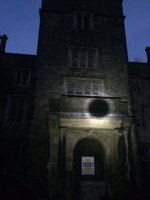The hall was built in the 1560s for the Winstanley family of Winstanley; the Winstanley family were lords of the manor since at least 1252 and may have been responsible for building the moat on the site. The Winstanleys owned the hall until 1596, when the estate was sold to James Bankes, a London goldsmith and banker. Winstanley Hall has three storeys and has a date stone with a date of 1584, but this is not in situ so may not provide an accurate date for the construction of the house. Extra blocks were added in the 17th and 18th centuries. Further and extensive alterations were made in 1811-19 by Lewis Wyatt in a Jacobean style. He moved the entrance to the left flank of the hall and replacing the original entrance with a window. The final additions to the hall were made in 1843 when an extra wing was added. To the south, on lands belonging to the hall, is a small stone building which was used to house bears that provided entertainment for the hall's guests. The Winstanley Family also owned the Braunstone Hall estate. The Bankes family retained ownership of the hall until the 21st century when it was sold for private development. The hall had been kept in good condition until the 1960s when habitation stopped. As the building decayed and the cost of maintaining Winstanley Hall was too much for the family it was sold on. It was intended to develop the hall into private flats, however refurbishment was held up due to Wigan council withholding planning permission.
I've got quite into crumbling country houses of late, and an old house keeps Cat happy as they break up the weekends I drag her around fetid empty cotton mills...
I kind of wish I had gone and seen this place a few years ago. It is a very interesting example of a Tudor house which has been tinkered with and extended over the years. It is also one of the first I have been in which has not been used as a school, care home or hospital, which meant it had not been chopped up with plasterwork.
One thing I love about these places was the customized details, which were first brought to my attention at Lennox Castle a few years ago. At Lennox the family crest incorporated a star and rose, and these symbols could be seen on various features around the house. For the Winstanley family, a long necked bird (I'm no ornithologist but perhaps a Crane?) seems to be the family symbol, and could be found cast into the iron fireplace, in the plasterwork, cut in the stone and carved into the wooden doors. I think it is a great sign of the wealth these people had to have afforded to commission a foundry pattern, plaster mould as well as stone masons and chippys to create these features... clearly "off the peg" was not an option here.
The sad thing as with so many of these fine houses is the vast cost to even stop it getting worse, let alone restore it. I think Winstanley is reaching that point of 'no return' where only the shell is savable economically speaking. Despite the decay and collapse, there are still some beautiful features to be seen.
I was told by the missus to not risk going upstairs... I'd like to go back at some point to have a pop at it.
I've never seen these wooden covered switches before, so they must have been bespoke or very expensive!
This is the remains of the servant's bell indicator panel. I would have loved to see it with it's glass panel in situ.
The bird motif in iron
And plaster


